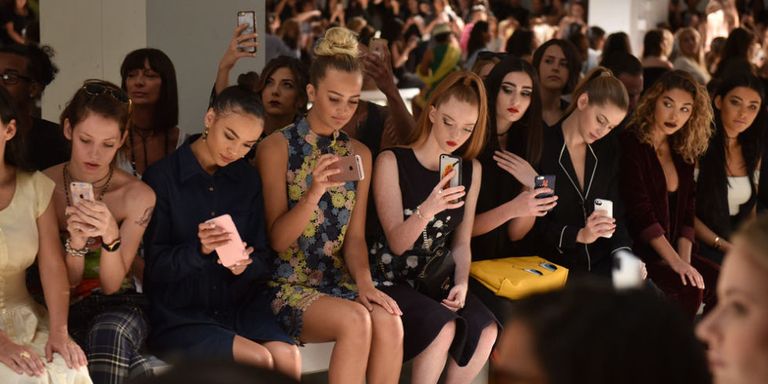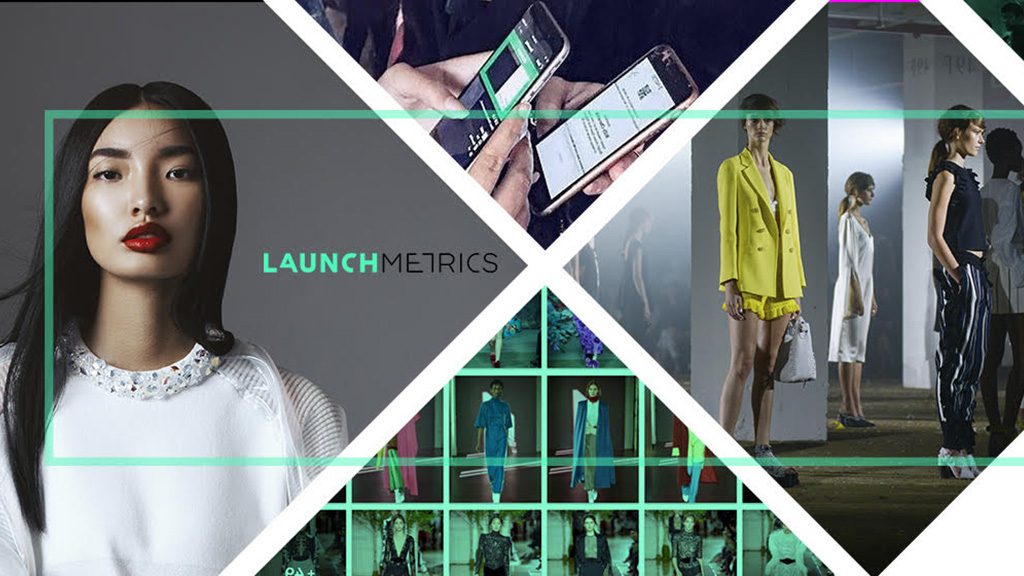Launchmetrics: the fortune-teller Fashion Week has been waiting for
Has Fashion Week become irrelevant? The question hangs in the air this month as magazine editors are replaced with Instagram influencers and exclusivity is lost to live streams at the fashion shows in New York, London, Milan and Paris. Digital advancements have turned Fashion Week on its head and brands have been left wondering where to go from here. Cue Launchmetrics, a data analytics platform equipped with an algorithm ready to solve designers’ woes. By signing up to their services brands can be informed on how worthwhile a Fashion Week show would be, however is it wise to treat prescriptive analytics as a crystal ball?
Fashion Week was initiated in 1943 (“Fashion Influencers Vs. Publishers At NYFW: A History Of The Rivalry”) as an outlet for designers to present their upcoming collections. In attendance would be the press and fashion buyers, the latter of who would place orders on the items they wanted in their stores the following season. Come 2019 and scoring an invite to a Fashion Week runway show denotes an entirely different experience.
The Council of Fashion Designers America (CFDA) recently conducted a research investigation: Examining the Future of New York Fashion Week (CFDA). The study proclaimed, “evolutions in technology, consumer behaviors, weather, and retail cycle have challenged the role and impact of the current fashion system” (CFDA 1).

The widespread use of live streams exposes the collections not only to the fashion-conscious public but also to competitors. Consequentially, fast-fashion brands replicate and sell similar styles months before the original designs hit stores. Combined with a new ‘buy now, wear now’ consumer mentality fostered by online retailers and next-day delivery, shoppers are expressing an “accelerated fatigue – of trends and designs” (CFDA 1). The immediacy of the digital era has rendered the seasonal fashion retail cycle as outdated.
Additionally, the rise of digital fashion influencers and their position front row has caused a hotly disputed interference with the established press coverage of Fashion Week. The disdain of fashion editors towards bloggers and influencers is conveyed in Vogue’s review of Milan Fashion Week – “Looking for style among a bought-and-paid-for (‘blogged out?’) front row is like going to a strip club for romance […] please stop. Find another business. You are heralding the death of style” (Singer et al.).
Journalism has reason to feel threatened, one social media post by an influencer can bring a company millions in profit – within 24 hours of influencer Arielle Charnas posting a Peter Thomas gel on her Snapchat story $17565 of product had been bought by her viewers (Strugatz). Mediakix.com identifies three benefits of hosting fashion influencers: the sporadic Fashion Week coverage from the press cannot compete with the regularity of content and engagement influencers maintain throughout the year, influencers are able to deliver highly personalized and thus memorable recounts of events and the relatable trait of influencers consolidates their audience’s trust (“Fashion Influencers Vs. Publishers At NYFW: A History Of The Rivalry”). Therefore brands are investing increasingly more of their budget into advertising through influencers and traditional press is taking a back seat.
The culmination of digital influence leads to the necessity of Fashion Week to adapt accordingly. The CFDA concludes their investigation by recommending designers re-consider their showcasing of collections, “The CFDA encourages designers to evaluate what is best for their brand, and will support innovation and experimentation” (CFDA 3). This debate over the on-going relevance of Fashion Week and whether or not it is worthwhile for a designer to continue investing in the practice is resolved with the interference of Launchmetrics.
A “marketing platform and data analytics to help fashion, luxury and cosmetics professionals discover, activate and measure the voices that matter for their brands” (“Launchmetrics”), Launchmetrics interprets hard data to assist brands in determining whether their ventures leads to a worthy return of interest (ROI) (Torres). In an interview with nowfashion.com Michael Jaïs, Launchmetrics’ CEO, shared that the platform focuses on “four main voices that drive the conversation and the value of the shows during fashion weeks – traditional media, the influencers, owned media, and the consumer” (Torres). The success of a designer no longer depends on business-to-business relationships but instead relies on producing the desired media impact value.

Launchmetrics consists of artificial intelligence and data scientists working side-by-side to monitor over 20000 brands, 50000 media outlets and 100000 influencers daily (“Launchmetrics, The Leading Marketing Platform In Fashion, Luxury And Cosmetics”). This allows the platform to manage their clients’ launch cycles, from influencer discovery to media monitoring and content and event management. Launchmetrics provide designers with accounts of their PR presence, media performance and position within the market whilst also recommending strategies for increased ROI. For example, the ‘Influencer Campaign Management’ service searches through Launchmetrics’ log of influencers to find those whose audience most accurately matches the target market of the designer and would thus instigate the greatest impact for the brand (“Launchmetrics”).
Launchmetrics is an initiative capitalizing on the current buzz surrounding data analytics within business. A buzz well deserved as companies conducting business analytics perform better in profitability, revenue and shareholder return (Evans). Business analytics refers to “a process of transforming data into actions through analysis and insights in the context of organizational decision making and problem solving” (Liberatore, and Luo 314) and is categorised into descriptive, diagnostic, predictive and prescriptive analytics (Banerjee et al.).
Converting information to insights prescriptive analytics, as utilized by Launchmetrics, is “provides organizations with adaptive, automated and time-dependent sequences of operational actions” (Soltanpoor, and Sellis 246). Thus data can be transformed into solutions, however be wary of this euphoria that prescriptive analytics seemingly presents.
“Big data’s power does not erase the need for vision or human insight” (McAfee, and Brynjolfsson 66) and growing dependency on AI generated algorithms risks the loss of critical human traits such as creativity, particularly important within the fashion industry. However without prescriptive analysis decision-making is left to what has been coined HiPPO (the highest-paid person’s opinion) (McAfee, and Brynjolfsson) regardless on whether they know what the best outcome to be. Thus, to construct decisions that are both innovative and business-savvy a brand would do well to combine Launchmetrics’ prescriptive analytics and a human team’s creativity and judgment.
As the Fashion Weeks for Spring/Summer 2020 draws to a close there is a sense of uncertainty evident amongst the ruffles and hairspray. Designers are turning to Launchmetrics for comfort and guidance and while the platform’s data analytics have proven to be effective in increasing a brand’s ROI it is important they do not forget the creativity that is essential to fashion.
Reference List
Banerjee, Arindam et al. “Data Analytics: Hyped Up Aspirations Or True Potential?”. Vikalpa: The Journal For Decision Makers, vol 38, no. 4, 2013, pp. 1-12. SAGE Publications, doi:10.1177/0256090920130401.
CFDA. The Results Are In: Examining The Future Of New York Fashion Week. 2016, https://cfda.imgix.net/2016/10/CFDA-Main-Article-VF.pdf.
Evans, James. “Business Analytics: The Next Frontier For Decision Sciences”. Cbpp.Uaa.Alaska.Edu, 2012, http://www.cbpp.uaa.alaska.edu/afef/business_analytics.htm.
“Fashion Influencers Vs. Publishers At NYFW: A History Of The Rivalry”. Mediakix, 2019, https://mediakix.com/blog/fashion-influencers-pr-new-york-fashion-week-history/.
Harper’s Bazaar. The Front Row At A Fashion Show. 2019, https://www.harpersbazaar.com/fashion/fashion-week/a17600/unglamorous-things-about-fashion-week/. Accessed 23 Sept 2019.
“Launchmetrics”. Launchmetrics, 2019, https://www.launchmetrics.com/.
“Launchmetrics, The Leading Marketing Platform In Fashion, Luxury And Cosmetics”. Fashionunited, 2018, https://fashionunited.uk/news/fashion/launchmetrics-the-leading-marketing-platform-in-fashion-luxury-and-cosmetics/2018112240126.
Liberatore, Matthew J., and Wenhong Luo. “The Analytics Movement: Implications For Operations Research”. Interfaces, vol 40, no. 4, 2010, pp. 313-324. Institute For Operations Research And The Management Sciences (INFORMS), doi:10.1287/inte.1100.0502.
McAfee, Andrew, and Erik Brynjolfsson. “Big Data: The Management Revolution”. Harvard Business Review, vol 90, no. 10, 2012, pp. 60-68.
Singer, Sally et al. “Ciao, Milano! Vogue.Com’s Editors Discuss The Week That Was”. Vogue, 2016, https://www.vogue.com/article/milan-fashion-week-spring-2017-vogue-editors-chat.
Soltanpoor, Reza, and Timos Sellis. “Prescriptive analytics for big data.” Australasian Database Conference. Springer, Cham, 2016.
Strugatz, Rachel. “Bloggers And Digital Influencers Are Reshaping The Fashion And Beauty Landscape”. Los Angeles Times, 2016, https://www.latimes.com/fashion/la-ig-bloggers-20160809-snap-story.html.
Torres, Robin. “NYFW’S Future Could Be An Algorithm. Are Fashion Shows Still Relevant?”. Now Fashion, https://nowfashion.com/nyfw-s-future-could-be-an-algorithm-are-fashion-shows-still-relevant-24424. Accessed 22 Sept 2019.